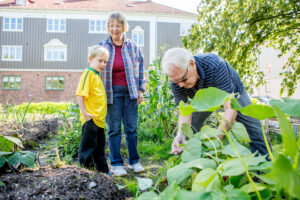The way a city is structured is important in promoting a healthy and active lifestyle. An environment that encourages physical activity not only contributes to a more vibrant and social city but also creates a safer environment, increased mobility, reduced noise, and better air quality.
Cities are often at the forefront when it comes to development and economic growth, but they also face the challenges of increased social inequalities and health disparities. The structure of a city plays an important role in shaping people’s lives and habits and can help stimulate physical activity like biking, walking, playing, or doing garden work.
A good living environment is fundamental for good health. For citizens to thrive, basic needs such as access to water, electricity, ventilation, and green areas are important, but so are social aspects such as safety, community involvement, and time for social activities. By acknowledging these factors from an early stage in the planning process, planners create a good foundation that aligns with the needs of the community.
The bike- and pedestrian-friendly city

Image by Werner Nystrand/imagebank.sweden.se
A city that is planned in favour of bikes and pedestrians fosters a more active and connected community. To encourage people to use the bike as a mode of transportation in their everyday lives, cities need to offer safe and attractive bike lanes that cater to all types of cyclists: children on their way to school as well as people commuting to their jobs.
With the increasing use of electric and cargo bikes, there are also new challenges for planning public spaces, but Swedish municipalities have extensive experience in planning bike infrastructure that encourages more people to choose cycling.
Despite walking being flexible and climate-friendly, pedestrians are not always prioritized in city planning today. Creating attractive and safe environments is fundamental to making walking an attractive option.
Children’s activity
Physical activity is crucial for children’s physical and psychological health and development. Play is a key aspect of their development, making it essential to design environments that encourage play, along with access to green spaces and parks. Community involvement is another important aspect for Swedes to feel like part of society and maintain a healthy life, and urban planning can help stimulate these opportunities.
Nature’s importance for a healthy city

Image by Emelie Asplund/imagebank.sweden.se
Research shows the importance and positive health effects related to people’s access to nature. Green areas contribute to reduced stress, promote physical activity and social interactions, and provide cleaner air. Other benefits include a stronger immune system, increased ability to concentrate, and better short-term memory.
Incorporating green areas in cities also creates spaces for recovery and relaxation. Studies show that people are willing to walk up to 300 meters to get to a green area. For this reason, the Swedish Board of Housing, Building and Planning recommends that green areas be located within 300 meters of schools and residential buildings.
Possibilities of social interaction
Today, segregation is increasing in many places around the world, leading to greater isolation among different societal groups. In Sweden, feelings of loneliness have increased over the past decades, making communal spaces in urban areas even more important. Creating spaces where people can meet, socialize, and learn from each other is therefore crucial in city planning, as it contributes to inclusiveness and positively impacts people’s well-being.